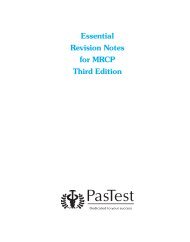EMQs for Medical Students - PasTest
EMQs for Medical Students - PasTest
EMQs for Medical Students - PasTest
Create successful ePaper yourself
Turn your PDF publications into a flip-book with our unique Google optimized e-Paper software.
E M Q s F O R M E D I C A L S T U D E N T S – V O L U M E 2<br />
secretions – hence the dry mouth), the bladder (inability to pass urine), eyes (blurring<br />
of vision) and many others. While some psychiatric disorders are clearly associated<br />
with constipation (eg depression) a causal relationship is less clear.<br />
3. J – Simple constipation<br />
Constipation is the second most common gastrointestinal symptom in the developed<br />
world after dyspepsia. In the majority, the symptom is mild and self-limiting. Low fluid<br />
intake, a low-fibre diet, and lack of exercise and mobility are all factors that contribute<br />
to simple constipation. In addition, it is a common accompaniment of ageing. Elderly<br />
inpatients such as the woman described here are very commonly affected by constipation<br />
<strong>for</strong> these reasons. Treatment should aim at reversing the above causative factors<br />
where possible but laxatives are usually required, at least in the short term.<br />
4. B – Chronic idiopathic constipation<br />
The long history from an early age and the female sex make an organic diagnosis very<br />
unlikely. When no organic cause can be found, the problem is described as ‘idiopathic’.<br />
The majority of such patients have intractable symptoms which do not<br />
respond to simple laxative therapy. The group can be further divided by physiological<br />
studies into those with a delay in transit in all or part of the colon (slow-transit constipation),<br />
those with abnormalities of rectal evacuation and those with no abnormality<br />
(‘constipation-predominant irritable bowel syndrome’). The cause or causes of such<br />
disorders are unclear.<br />
5. F – Hypercalcaemia<br />
The diagnosis can be deduced indirectly. This man is likely, on the basis of the history,<br />
to have a carcinoma of the bronchus (cough and haemoptysis). Hypercalcaemia can<br />
occur quite commonly with lung cancer due to malignant infiltration of bone (osteolysis<br />
and calcium release) or due to ectopic secretion by the tumour of parathyroid<br />
hormone- (PTH-) like hormone. The bowel can also rarely be affected by autoantibodies<br />
to myenteric neurones in association with small-cell carcinoma of the lung. In<br />
this situation, intestinal pseudo-obstruction develops. While severe constipation does<br />
occur with pseudo-obstruction, the main presentation is with small-bowel obstruction<br />
(leading to distension and vomiting).<br />
5. DIARRHOEA<br />
1. C – Bacterial enterocolitis<br />
This patient has bacterial enterocolitis, as evidenced by the history of <strong>for</strong>eign travel and<br />
the symptoms and signs. A preceding flu-like ‘prodrome’ is also common be<strong>for</strong>e diarrhoea<br />
ensues. Common causative infective agents include Escherichia coli and species<br />
of Salmonella, Shigella and Campylobacter. Amoebic dysentery is by definition associated<br />
with bloody diarrhoea.<br />
2. D – Caecal carcinoma<br />
This gentleman has the classic clinical presentation of a caecal carcinoma, with a<br />
change in bowel habit (usually to diarrhoea), weight loss and microcytic anaemia.<br />
164

















